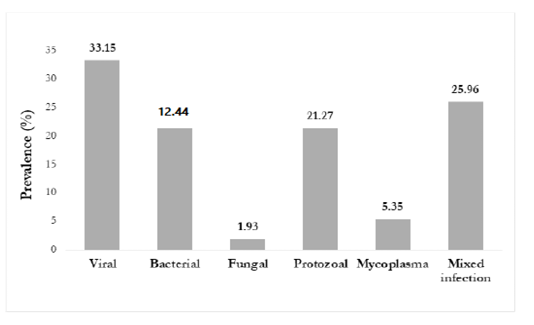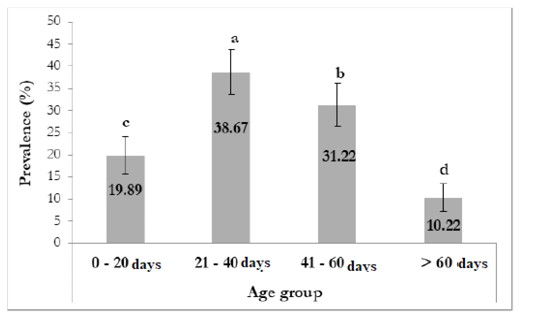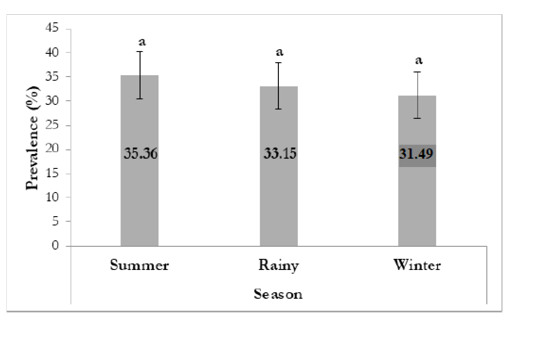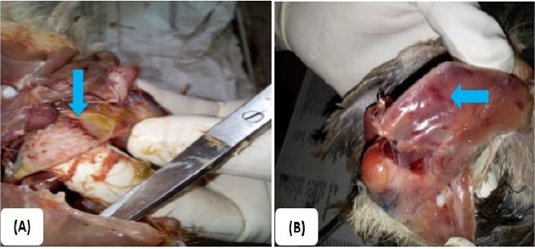Advances in Animal and Veterinary Sciences
Research Article
Prevalence and Pathological Affections of Infectious Diseases in Sonali Chickens in the Kishoreganj District of Bangladesh
Jahid Hasan Tipu1, Mohammad Al Mamun1*, Monira Noor1, Md. Irtija Ahsan2, Md. Jamal Uddin Bhuiyan3
1Department of Pathology, Sylhet Agricultural University, Sylhet-3100, Bangladesh; 2Department of Epidemiology and Public Health, Sylhet Agricultural University, Sylhet-3100, Bangladesh; 3Department of Parasitology, Sylhet Agricultural University, Sylhet-3100, Bangladesh.
Abstract | Infectious diseases are one of the major constraints in Sonali chicken production in the Kishoreganj district of Bangladesh. However, the estimates of their prevalences including their pathological affections were limited. Therefore, we designed a retrospective cross-sectional study with a total of 362 Sonali birds from March 2018 to February 2019 to explore the prevalences and pathological changes of different infectious diseases in this district. Results showed that, coccidiosis attributed the highest prevalence (21.27%) in Sonali chickens among the infectious diseases, as the magnitudes of IBD (18.51%) and ND (14.64%) were moderate, whilst colibacillosis (5.53%), mycoplasmosis (5.25%), salmonellosis (3.59%), and fowl cholera (3.32%) showed a lower burden. The results also revealed a significant variation (p < 0.05) in the susceptibility to diseases at different ages; as 0-20 days age group was more susceptible to IBD, 21-40 days age group to coccidiosis, 41-60 days age group to ND, and above 60 days age group to colibacillosis. Despite a little variation in overall seasonal prevalences, some specific infectious diseases, like IBD showed a higher occurrence in the winter (26.32%) and summer (17.97%), while coccidiosis in the rainy season (26.32%), than other diseases. The typical pathological changes were observed in the birds affected with ND, IBD, and coccidiosis. These results provide an overall scenario of infectious diseases of Sonali chickens in the study area, which guides both the disease control authority to prioritize the disease burden and to plan their efficient control strategies and the Sonali raisers to orchestrate their disease management protocols.
Keywords | Infectious diseases, Prevalences, Pathological investigation, Sonali chicken, Kishoreganj, Bangladesh.
Received | March 12, 2021; Accepted | March 17, 2021; Published | July 28, 2021
*Correspondence | Mohammad Al Mamun, Department of Pathology, Sylhet Agricultural University, Sylhet-3100, Bangladesh; Email: [email protected]
Citation | Tipu JH, Al Mamun M, Noor M, Ahsan MI, Bhuiyan MJU (2021). Prevalence and pathological affections of infectious diseases in sonali chickens in the kishoreganj district of bangladesh. Adv. Anim. Vet. Sci. 9(9): 1317-1323.
DOI | http://dx.doi.org/10.17582/journal.aavs/2021/9.9.1317.1323
ISSN (Online) | 2307-8316; ISSN (Print) | 2309-3331
Copyright © 2021 Mamun et al. This is an open access article distributed under the Creative Commons Attribution License, which permits unrestricted use, distribution, and reproduction in any medium, provided the original work is properly cited.
INTRODUCTION
The poultry sector, an important business-oriented tool in global efforts, contributes to overcoming the malnutrition and alleviation of poverty in the developing countries. As an unparalleled platform for a quick profit, it is considered as a farmer’s first investment in the livestock ladder for income generation, which facilitates them escaping from the poverty trap through employment creation (Rahman et al., 2017). Moreover, this sector is uncompromising to meet up the demand for good quality protein through supplying meat and eggs at a reasonable price.
In a developing country like Bangladesh, the swiftly growing poultry sector contributes to a significant development in the national economy. Poultry provides two major sources of animal protein in this country are meat and egg, of which poultry meat alone contributes 37% of the total meat production (Begum et al., 2011). Per capita, poultry meat consumption in Bangladesh has increased to around 7 kg in 2020, which was 6.5 kg in 2019 (Dhaka Tribune, 2019; WPSA, 2020), and per capita, annual consumption of egg is 103.89 against the minimum requirement of 104 (DLS, 2019). So, specialists encourage the establishment of poultry farms in this country for the advancement of the national health status and the socio-economic conditions of the people.
The Sonali chicken, a cross between Rhode Island Red (RIR) cocks and Fayoumi hens, has an identical phenotypic outlook to that of local chickens, which was introduced through the Smallholder Livestock Development Project (SLDP) and Participatory Livestock Development Project (PLDP) in 1996-2000 in the northern parts of Bangladesh for meat production. These birds had good survivability and adaption to the macroclimatic conditions of this country, as they require less concern, attention, and care, compared to other poultry breeds (Saleque and Saha, 2013). Since 2010, the population of Sonali chickens has been progressively increasing, about 150.9 million Sonali Day Old Chicks (DOCs) were produced, which represents about 35% of the total commercial broiler and layer production of the country. In response to the high market demand, small and marginal farmers have started to rear Sonali chickens commercially (FAO, 2015). Despite these positive motives behind rearing Sonali chickens, there are some major constraints, particularly infectious diseases which obstruct their optimum production and lead to substantial economic losses in terms of morbidity and mortality (Biswas et al., 2006; Islam and Samad, 2004). A study was conducted on the southeastern coast of Bangladesh, reported about 28% mortality in Sonali chickens due to outbreaks of different infectious diseases (Biswas et al., 2006). The geo-climatic conditions, seasons, age, management practices, and immunization status of the birds are important determinants having an impact on the development and maintenance of infectious diseases in the area (Uddin et al., 2010). Kishoreganj district, a densely populated poultry zone, is one of the major poultry hubs in this country, especially for Sonali chickens. However, evidence on the estimate of the prevalences of various infectious diseases developed in Sonali chickens in this area is limited except seasonal prevalence reported by Al Mamun et al. (2019). Therefore, we conducted this study to explore the prevalences of different infectious diseases of Sonali chickens including more determinants like age, seasons, and geographical location, and to investigate the pathological changes caused by them in Kishoreganj district, Bangladesh.
MATERIALS AND METHODS
Study area
We conducted the study in the Kishoreganj district of Bangladesh, which locates between 24°02’ and 24°39’ north latitudes and in between 90°35’ and 91°15’ east longitudes (Banglapedia, 2020). The average temperature in the study area is 24.7°C with 2250 mm annual rainfall (Climate-Data, 2020).
Target population, study population, and study unit
The target population was the entire Sonali chicken population in the study area. In the current investigation, due to limited resources we employed a passive data collection method that impacted on the design of the study population as the total number of Sonali chickens either live or dead, which were brought to District Veterinary Hospital (DVH), Kishoreganj, from different Sonali farms of the district. The study unit, in this study, was the individual bird.
Study design, sampling frame, and data collection
We designed a retrospective cross-sectional study over one year from March 2018 to February 2019 to measure the prevalences of infectious diseases in Sonali chickens. The sampling frame included a total of 362 Sonali birds either live or dead that were brought at District Veterinary Hospital (DVH), Kishoreganj, Bangladesh. In the present study, the sampling frame defined the study population, as data was collected from every unit in the sampling frame. We gathered data of cases of Sonali chickens including the information about age and season passively from the hospital’s case register.
Diagnosis of diseases and observation of pathological changes
Veterinary doctors, at DVH, diagnosed diseases based on clinical history, clinical signs, and additionally, by performing post-mortem examinations described by Swayne et al. (2013). However, in some cases, they did serological tests for confirmative diagnosis. Amid the tenure of this study, the author, JHT, had an internship placement at DVH from 20th June 2018 to 19th July 2018, who directly observed and recorded the pathological changes during post-mortem examinations at the time of diagnosis.
Data entry and data management
We entered collected raw data in a spreadsheet using Microsoft Office Excel 2010. We divided the whole year into three seasons to study the seasonal variations as summer (March-June), rainy (July-October), and winter (November-February) as described by Al Mamun et al. (2019). Farmers commercially rear Sonali chickens for 60 days mainly for meat production; however, some farmers keep the chickens for more than 60 days for egg purposes. Considering this fact, we categorized Sonali chickens into four age groups as 0-20 days, 21-40 days, 41-60 days, and above 60 days.
Estimation of prevalences
We calculated hospital-based period prevalences as the proportion of a particular case (n) among the total number of cases (N), using the formula as reported by Al Mamun et al. (2019). In the present study, firstly, we estimated the overall prevalence of diseases, secondly, overall prevalences by causal pathogens, then, overall prevalences by age and season, and finally disease-specific prevalences by age and season. Besides, we calculated 95% confidence intervals (CI) of the prevalences for generalization to the population.
Statistical Analysis
We employed a two-sample proportion test in the chi-square format following the cross tabulation model to identify the statistical difference in overall prevalences between each of the age groups and seasons (Elliott and Reisch, 2006; Schumacker and Tomek, 2013). We considered the p-value less than 0.05 as a significant difference between the two prevalences. We performed data analysis in IBM SPSS Statistics v.24.0 and SAS university edition.
RESULTS
Results showed that a number of important infectious diseases affected Sonali chickens in the study area, like coccidiosis, Infectious Bursal Disease (IBD), Newcastle Disease (ND), colibacillosis, mycoplasmosis, salmonellosis, fowl cholera, and aspergillosis. We have found the highest prevalences in coccidiosis followed by IBD, ND, IBD + Coccidiosis, ND + Coccidiosis, colibacillosis, mycoplasmosis, ND + IBD + Coccidiosis, salmonellosis, fowl cholera, aspergillosis, and the lowest in ND + Colibacillosis (Table 1).
Results of the prevalences of infectious diseases based on their causal agent showed that, viral diseases were the highest (33.15%) in Sonali chickens followed by mixed infection (25.96%), protozoal (21.27%), bacterial (12.44%), mycoplasma (5.25%), and the lowest was fungal infection (1.93%) (Figure 1).

Figure 1: Overall prevalence of infectious diseases by their causal agents in Sonali chickens in Kishoreganj district of Bangladesh during the period from March 2018 to February 2019
The current results revealed IBD (40.28%) as the most prevalent disease in the 0-20 days age group. However, coccidiosis was the highest (26.43%) in the 21-40 days age group. Besides, ND and colibacillosis occurred most in the 41-60 days age group (33.63%) and above 60 days age group (24.32%), respectively. These findings also expressed that, the occurrence of infectious diseases in Sonali chickens varied among the age groups (Table 2).
In this study, in case of overall prevalences of infectious diseases in Sonali chickens by age, we recorded the high
Table 1: Overall prevalence of infectious diseases of Sonali chickens in Kishoreganj district of Bangladesh during the period from March 2018 to February 2019
| Name of the diseases | No. of positive cases (n) | Prevalence (%) | 95% CI |
| Aspergillosis | 7 | 1.93 | 0.51-3.34 |
| Coiccidiosis | 77 | 21.27 | 17.04-25.51 |
| Colibacillosis | 20 | 5.53 | 3.16-7.89 |
| Mycoplasmosis | 19 | 5.25 | 2.94-7.56 |
| Fowl Cholera | 12 | 3.32 | 1.46-5.17 |
| IBD | 67 | 18.51 | 14.49-22.53 |
| IBD + Coccidiosis | 47 | 12.98 | 9.50-16.46 |
| ND | 53 | 14.64 | 10.98-18.29 |
| ND + Coccidiosis | 24 | 6.63 | 4.05-9.20 |
| ND + Colibacillosis | 5 | 1.38 | 0.17-2.59 |
| ND + IBD + Coccidiosis | 18 | 4.97 | 2.72-7.22 |
| Salmonellosis | 13 | 3.59 | 1.67-5.52 |
| Total | n=362 | 100 |
Table 2: Disease specific prevalence of infectious diseases in different age groups of Sonali chickens in Kishoreganj district of Bangladesh during the period from March 2018 to February 2019
| Name of the diseases | Age | |||||||
| 0-20 days | 21-40 days | 41-60 days | > 60 days | |||||
| Case no. (n=72) |
*Prev. (%) |
Case no. (n=140) |
*Prev. (%) |
Case no. (n=113) |
*Prev. (%) |
Case no. (n=37) |
*Prev. (%) |
|
| Aspergillosis | 7 | 9.72 | 0 | 0 | 0 | 0 | 0 | 0 |
| Coccidiosis | 22 | 30.56 | 37 | 26.43 | 17 | 15.04 | 1 | 2.70 |
|
Colibacillosis |
0 | 0 | 3 | 2.14 | 8 | 7.08 | 9 | 24.32 |
| Mycoplasmosis | 0 | 0 | 11 | 7.86 | 6 | 5.31 | 2 | 5.41 |
|
Fowl Cholera |
0 | 0 | 1 | 0.72 | 4 | 3.54 | 7 | 18.92 |
| IBD | 29 | 40.28 | 36 | 25.71 | 2 | 1.77 | 0 | 0 |
|
IBD + Coccidosis |
13 | 18.05 | 32 | 22.86 | 2 | 1.77 | 0 | 0 |
| ND | 0 | 0 | 8 | 5.71 | 38 | 33.63 | 7 | 18.92 |
|
ND + Coccidiosis |
0 | 0 | 1 | 0.71 | 21 | 18.58 | 2 | 5.41 |
| ND + Colibacillosis | 0 | 0 | 0 | 0 | 3 | 2.66 | 2 | 5.41 |
| ND+IBD+Coccidiosis | 0 | 0 | 10 | 7.14 | 8 | 7.08 | 0 | 0 |
| Salmonellosis | 1 | 1.39 | 1 | 0.72 | 4 | 3.54 | 7 |
18.92 |
*Prev. = Prevalence
est prevalence as 38.67% in 21-40 days age group, then 31.22% in 41-60 days age group, 19.89% in 0-20 days age group, and the lowest prevalences as 10.22% in above 60 days age group. Furthermore, we obtained that overall prevalences varied significantly (p < 0.05) between each of these four age groups, which was an important finding of this study, indicating a substantial variation in susceptibility to infectious diseases at different age groups (Figure 2).

Figure 2: Overall prevalence of infectious diseases in Sonali chickens by age in Kishoreganj district of Bangladesh during the period from March 2018 to February 2019
Prevalence with the different superscript have significant variation (p < 0.05)
However, despite the insignificant overall seasonal variation in prevalence, some specific infectious diseases showed a tendency to occur more at definite seasons. We have obtained that the prevalences of IBD were higher in the summer (17.97%) and winter (26.32%) than other infectious diseases. Accordingly, among the diseases, the prevalence of coccidiosis (29.17%) was higher in the rainy season (Table 3).
In the case of the overall prevalence of infectious diseases in Sonali chickens by season, we recorded the highest prevalences in the summer season (35.36%), followed by the rainy season (33.15%), and the lowest in the winter season (31.49%). However, there was no significant variation (p > 0.05) in overall prevalences between each of the three seasons (Figure 3).

Figure 3: Overall prevalence of infectious diseases in Sonali chickens by season in Kishoreganj district of Bangladesh during the period from March 2018 to February 2019
Prevalence with the same superscript have no significant variation (p > 0.05)
The post-mortem findings of ND revealed pinpoint hemorrhage at the tip of the proventricular gland and hemor-
Table 3: Disease specific seasonal prevalence of infectious diseases in Sonali chickens in Kishoreganj district of Bangladesh during the period from March 2018 to February 2019
| Name of the diseases | Summer | Rainy | Winter | |||
| No. of cases (n=128) |
*Prev. (%) |
No. of cases (n=120) |
*Prev. (%) |
No. of cases (n=114) |
*Prev. (%) |
|
| Aspergillosis | 2 | 1.56 | 4 | 3.33 | 1 | 0.88 |
| Coiccidiosis | 21 | 16.41 | 35 | 29.17 | 21 | 18.42 |
| Colibacillosis | 7 | 5.47 | 8 | 6.67 | 5 | 4.39 |
| Mycoplasmosis | 5 | 3.91 | 5 | 4.17 | 9 | 7.89 |
| Fowl Cholera | 3 | 2.34 | 6 | 5.00 | 3 | 2.63 |
| IBD | 23 | 17.97 | 14 | 11.67 | 30 | 26.32 |
| IBD + Coccidiosis | 22 | 17.19 | 16 | 13.32 | 9 | 7.89 |
| ND | 21 | 16.41 | 13 | 10.83 | 19 | 16.67 |
| ND + Coccidiosis | 13 | 10.16 | 4 | 3.33 | 7 | 6.14 |
| ND + Colibacillosis | 1 | 0.78 | 2 | 1.67 | 2 | 1.75 |
| ND+IBD+Coccidiosis | 6 | 4.68 | 8 | 6.67 | 4 | 3.51 |
| Salmonellosis | 4 | 3.12 | 5 | 4.17 | 4 |
3.51 |
*Prev. = Prevalence
rhage in the caecal tonsil (Figure 4). The gross pathological lesions of IBD were represented as lining hemorrhage at the junction of proventriculus and gizzard, as well as, hemorrhage in thigh and breast muscle (Figure 5). The post-mortem findings of coccidiosis included hemorrhages and engorged clotted blood in the caecum (Figure 6).

Figure 4: Post-mortem findings of ND; (A) pinpoint hemorrhage at the tip of the proventricular gland and (B) hemorrhage in caecal tonsil

Figure 5: Post-mortem findings of IBD; (A) hemorrhage at the junction of proventriculus and gizzard and (B) hemorrhage in thigh and breast muscle
DISCUSSION
The current results revealed that the most frequent infectious diseases of commercial birds like broiler and layer in this country were coccidiosis, ND, IBD, colibacillosis, and salmonellosis, were also present in Sonali chicken population of Kishoreganj district. These results coincided with those of the other investigators who showed the susceptibility of Sonali chickens to different infectious diseases, affecting other commercial birds in this country (Hasan et al., 2017; Talukdar et al., 2017; Belal, 2017).
The present study revealed the overall prevalence of coccidiosis was 21.27% in Sonali chickens. Hasan et al. (2017) studied the prevalence of coccidiosis from the nearby Joypurhat district of Bangladesh and reported a prevalence of 21.09%, which strongly supported the findings of the present study. However, Talukdar et al. (2017) and Belal (2017) reported a lower (10.70%) and higher (35.45%) prevalence of coccidiosis in the Bogra Sadar Upazila and Sirajgonj district of Bangladesh, respectively compared to that recorded in the current study. This variation in prevalence might be due to the differences in diagnostic procedures, geographical locations, and management, which plays an important role in increasing the susceptibility to the disease. In the present study, we calculated the overall prevalence of ND as 14.64% in Sonali chickens in the Kishoreganj district. This estimate was close to the findings of Hasan et al. (2017) and Talukdar et al. (2017) who reported 19.39% and 11.24% prevalence of ND in Sonali chickens in the Jaypurhat and Bogura district, respectively. The overall prevalence of IBD in the current study was 18.51%. This result was in line with the findings of Talukdar et al. (2017) and Mshelia et al. (2016) who reported 14.72% and 17.86% prevalence of IBD, respectively, in Sonali chickens. However, the prevalence was slightly lower than the estimate reported by Hasan et al. (2017). This discrepancy in prevalence might be due to differences in geographical locations, study designs, and rearing systems. The present study revealed that aspergillosis attributed 1.93% of total cases in Sonali chickens. This estimate agreed with the findings of Hasan et al. (2017) who reported 1.02% of total cases were caused by aspergillosis. According to the present investigations, the prevalences of colibacillosis and salmonellosis were 5.52% and 3.59%, respectively. However, Hasan et al. (2017) and Al Mamun et al. (2019) reported a considerably higher prevalence of colibacillosis (15.31%) and salmonellosis (27.31%), respectively, than the estimate of the present investigation. These differences might be due to the variation in the study period and farm management. The present study revealed a 3.32% overall prevalence of fowl cholera in Sonali chickens in the Kishoreganj district. Hossain et al. (2017) reported an 11.25% prevalence of fowl cholera in Sonali chickens in the Gazipur district of Bangladesh. In the current study, the prevalence of viral diseases (33.15%) was highest in Sonali chickens in the Kishoreganj district. This result agrees with the findings of Al Mamun et al. (2019) who also showed that, the most of cases were attributed due to viruses in a previous study conducted in the same district.
Overall prevalences by age group and disease-specific prevalences expressed that the occurrence of the infectious diseases in Sonali chickens varied among the age groups. We recorded the highest prevalence of ND (33.63%) at a relatively older age (41-60 days age group) compared to other age groups. Islam et al. (2016) showed that the occurrence of ND was higher in the adult commercial chickens in this country, which supports the present study. The present study indicated that, aspergillosis tended to occur in the young birds (0-20 day age group). A former study also reported the occurrence of this fungal disease at a young stage in other commercially reared chickens (Sultana et al., 2015).
In the case of disease-specific prevalences by season, the current study revealed that coccidiosis usually occurs around the year, however, the prevalence (29.17%) was higher in the rainy season (July-October) than in other seasons due to the wet conditions of the environment. The results of the current study were following the study of Belal (2017) who reported a 26.82% prevalence of coccidiosis in the rainy season (July-October). Accordingly, we obtained that the disease-specific prevalence of IBD was higher in winter (26.32%) and summer (17.97%) than the rainy season. These findings match with the findings of Al Mamun et al. (2019) who showed a higher occurrence of IBD in the winter and summer seasons than the rainy season.
The gross lesions of ND were pinpoint hemorrhage at the tip of the proventricular gland and hemorrhage in the caecal tonsil. Uddin et al. (2014) found such lesions in ND, which supports the present investigation. Besides, the gross pathological lesions of IBD were lining hemorrhage at the junction of proventriculus and gizzard, as well as hemorrhage in the thigh and breast muscle. Islam et al. (2016) observed similar changes in gross lesions in the case of IBD, which agrees with the present findings. In this study, the post-mortem findings of coccidiosis revealed hemorrhages and engorged clotted blood in the caecum, which is supported by Talukdar et al. (2017) who found similar gross lesions in coccidiosis.
CONCLUSION
The present study revealed that, Sonali chicken population in the Kishoreganj district of Bangladesh was affected by most of the notorious infectious diseases. The overall prevalence of coccidiosis was the highest among these infectious diseases, though the results of overall prevalence by their causal pathogens showed that most of cases were attributed by viruses. Moreover, this study disclosed that the occurrence of the infectious diseases in Sonali chickens varied among the age groups, suggesting age as an important determinant. Despite obtaining a little impact of season on overall prevalence, some infectious diseases showed their specificity to different seasons. Thus, we believe, this study provides an overall scenario of prevalence of infectious diseases of Sonali chickens, which assists to control the diseases and to adopt effective strategies against the outbreak of these infectious diseases.
ACKNOWLEDGEMENTS
The authors cordially express their sincere appreciation to the authorities of District Veterinary Hospital (DVH), Kishoreganj for their cordial cooperation and allowed to carry out the research work.
CONFLICT OF INTEREST
The authors declare no conflict of interest.
authors contribution
All the authors have contributed equally to carried out the whole research work and for preparing the final manuscript.
REFERENCES







